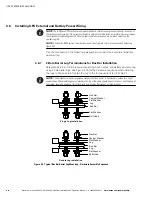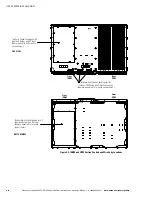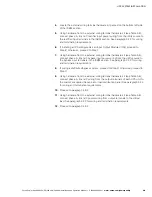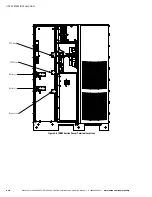
UPS INSTALLATION PLAN AND UNPACKING
Eaton
Power Xpert 9395P UPS (300 kVA, 300 kW) Installation and Operation Manual
S
P-164000563 Rev 1
www.eaton.com/powerquality
3-13
C
A
U
T
I
O
N
To reduce the risk of fire, connect only to a circuit provided with maximum input circuit breaker current
ratings from Table 3‐11 in accordance with the NEC, ANSI/NFPA 70.
MISE EN GARDE!
Pour réduire le risque d’incendie, ne brancher qu’à un circuit avec le courant nominal maximal du disjoncteur
d’entrée indiqué dans le tableau 3-14 (Table 3‐11,) conformément à la norme ANSI/NFPA 70 du NEC.
The line‐to‐line unbalanced output capability of the UPS is limited only by the full load
per phase current values for AC output to critical load shown in Table 3‐4 and
Table 3‐5. The recommended line‐to‐line load unbalance is 50% or less.
Bypass and output overcurrent protection and bypass and output disconnect switches
are to be provided by the customer. Module Output Breakers (MOBs) are to be
provided by the customer. Table 3‐12 lists the recommended rating for bypass,
output, and MOB circuit breakers. Bypass breakers are not applicable for IOM
configurations.
Table 3‐12. Recommended Bypass, Output, and MOB Circuit Breaker Ratings
UPS Model
Bypass, Output, and MOB Rating
Load Rating
480V
Eaton 9395P-300/300
Eaton 9395P-300/275
100% Rated
400A
Eaton 9395P-300/250
100% Rated
350A
Eaton 9395P-300/225
Eaton 9395P-300/200
100% Rated
300A
NOTE 1
Bypass breakers are not required for IOM configurations.
There is no manual DC disconnect device within the UPS.
A battery disconnect switch is required for battery systems and may also be required
by NEC or local codes. The battery disconnect switch should be installed between the
battery and the UPS.
Battery voltage is computed at 2 volts per cell as defined by Article 480 of the NEC.
Rated battery current is computed at 2 volts per cell.
The battery wiring used between the battery and the UPS should not allow a voltage
drop of more than 1% of nominal DC voltage at rated battery current.
External DC input overcurrent protection and disconnect switch is to be provided by
the customer. Table 3‐13 and Table 3‐14 list the maximum ratings for continuous‐duty
rated circuit breakers satisfying the criteria for both. Recommended disconnect size is
based on a maximum full load discharge time less than 3 hours. For longer discharge
times a larger disconnect may be required.
















































